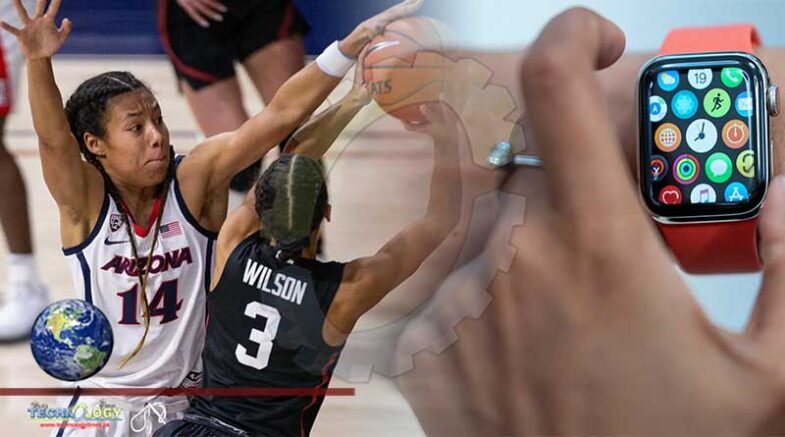The Pac-12’s introduces new tracking device. The Wildcats wear SafeTags, a device that times how long people are in close contact with each other.

The Wildcats’ first two road scares of the 2020-21 season came on their very first trip.
Arizona narrowly escaped Colorado with a 62-59 come-from-behind victory on Dec. 18. Afterward, the UA was told two Buffaloes players might have had COVID-19.
Colorado postponed its next game.
But what about the Wildcats, who had just played 40 minutes of physical basketball against the Buffs?
Adia Barnes sweated out every moment that passed. One of the UA coach’s worst fears — that her team would be exposed, get sick and knocked out of a promising season — seemed to be happening.
The Pac-12’s new tracking device kept it from becoming a full-blown nightmare. The Wildcats wear SafeTags, a device that times how long people are in close contact with each other.
To contact-trace, the Wildcats downloaded information from the electronic chips at a docking station and simply read the data. They learned that CU’s two presumed positive players included a shooter who stayed in the corner on most of the Buffaloes’ offensive sets and a bench player.
“It’s just cool to see that data and be able to feel safe,” UA senior Sam Thomas said. “It’s really nice to know, if someone does, gosh forbid, catch it from someone we played with, we’re able to … track everything to be as safe as you can.”
Randy Cohen, the UA’s associate director of athletics for CATS medical services, describes the SafeTag as a “double-wide zip drive.” It’s 1 inch by 1¼ inches in size and a half-inch thick. The square blinks red when coaches, staff or players are within 6 feet of each other. It blinks green if they are further apart. (The chips also beep, but the UA has turned that function off).
Arizona’s football, men’s basketball and women’s basketball teams have all been using SafeTags. On the road, the Wildcats women wear it all time. They can see what the data says about their time spent together on the bus, on the plane and watching film in the arena or a hotel conference room.
Every Wildcat has their own chip with their name on it. For practice, some women’s players put in SafeTags in their sports bra or socks. Others put it on a lanyard around their necks or wear it around their wrists on a bracelet or watch.
Before games — including Sunday’s showdown against Oregon State — the Wildcats slide their SafeTags into a slit in the waistband of their shorts.
“You don’t ever notice it when you are playing,” Thomas said.
The data provided by the SafeTags helps the Wildcats speed up the often time-consuming process of contact tracing when they’re informed of positive tests.
“It’s pretty interesting data,” Barnes said. “Sometimes I look at it like, ‘Wow, I was around her way too long.’ It’s because it’s natural to go stand near someone and talk.”
While Thomas and her teammates take all their new protocols seriously, there have been some light moments.
“Sometimes there’s a little malfunction — we’ll all be watching film and all of a sudden someone will start beeping and we’re like, ‘What is that? What is that?’ until we realize it is our tracker,” Thomas said with a laugh. “…You see (UA assistant) Salvo (Coppa), sometimes when he’s in the front going through the scout, he’ll walk one way — because he walks and he talks. If he’s close to someone, he looks at his ankle (at his chip) and he starts walking the other way trying to get away from everybody.”
Cohen has seen the value of the chips after just six weeks.
“I think the ability to educate people — how close is a close contact?” he said. “People say, ‘I wasn’t near them,’ and then you show them the data. If you can educate people well enough to take one step backwards or go outside or use a mask the whole time, that’s the key.
“You can say there was a super-spreader, and one person didn’t get it. Why? Because they wore their mask the whole time. What’s the difference? They didn’t take it down. You can reinforce that it does work. You have the data — it’s really good for that type of education.”
Originally published at Tuscon
